 |
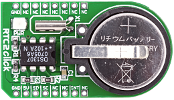
|
|
The RTC2 Click board is an accessory board in mikroBus form factor, featuring the DS1307 serial real-time clock (RTC). It is a low-power, full binary-coded decimal (BCD) clock/calendar with programmable square-wave output signal. The board uses the I2C interface for communication, and can only be used with a 5V power supply. The board features a 3V/230mA lithium battery as a backup power supply, which ensures that timekeeping operation continues even when the main power supply turns off. |
|
|
|
 |
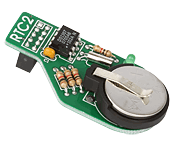
|
|
Add a Real-Time Clock (RTC) to your applications using the RTC2 Board. It features a serial real-time clock (RTC) DS1307 that is a low-power clock/calendar with 56 bytes of NV SRAM. There is also an on-board battery providing power supply backup |
|
|
|
 |
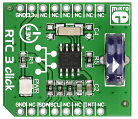
|
|
RTC3 click carries BQ32000, a real time clock with an integrated trickle charge circuit for automatic switchover to a backup power supply (the circuit maintains the backup charge with an onboard super capacitor). The clock frequency is derived from an onboard 32.768KHz oscillator. RTC3 click communicates with the target board microcontroller through mikroBUS I2C lines: SCL, SDA. In addition, the INT pin serves as a configurable interrupt output. The board is designed to use a 3.3V power supply only. |
|
|
|
 |
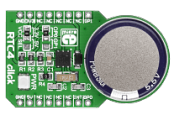
|
|
RTC4 click carries DS2417, a real time clock/calendar with a 1-Wire MicroLAN interface and a programmable interrupt for system output. The clock frequency is derived from an onboard 32.768KHz oscillator. An integrated backup energy source maintains a charge with an onboard coin cell supercapacitor. The clock has an accuracy of +/-2 minutes per month at a 25 degrees Celsius temperature. Depending on the position of the onboard jumper, RTC4 click communicates with the target board MCU either through mikroBUS AN or PWM pin (here, GPI01, GPIO0), plus the INT pin. The board is designed to use either a 3.3V or 5V power supply. |
|
|
|
 |
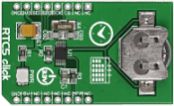
|
|
RTC5 click carries MCP79510, a real-time clock/calendar with an SPI interface (mikroBUS MISO, MOSI, SCK and CS pins); along with a programmable interrupt for system output. The clock frequency is derived from an onboard 32.768KHz oscillator. For backup power, RTC5 click has a coin-cell Lithium polymer battery connector. The chip has 64-bytes of battery-backed SRAM and 1 kbit of EEPROM for storing data, along with 128 bits of protected space for storing a unique ID. The clock/calendar automatically compensates for leap years and months shorter than 31 days. The board is designed to use a 3.3V power supply only. |
|
|
|
 |

|
|
RTC6 click carries Microchip's MCP79410 Real-Time Clock/Calendar IC with built-in 64 bytes of battery-backed SRAM an additional 1 Kbit of EEPROM. 64 bits of protected EEPROM requires an unlock sequence to be unlocked, which makes it suitable for storing a unique ID or other critical information. RTC6 click tracks hours, minutes, seconds, days, months, years and weekdays, with leap year compensation until the year 2399. The clock frequency is derived from an onboard 32.768KHz crystal oscillator. Backup power is supplied by a coin-cell Lithium battery. RTC6 communicates with the target board MCU through the mikroBUS I2C interface (SCL, SDA) along with a multifunction pin (MFP, in place of default mikroBUS INT pin). The multifunctional pin (MFP) can be configured as an alarm, a square wave frequency output, or a general purpose output. The board is designed to use either a 3.3V or a 5V power supply. |
|
|
|
 |
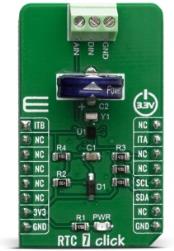
|
|
RTC 7 Click is a real time clock module which has an extremely low power consumption, allowing it to be used with a single button cell battery or a super capacitor, for an extended period of time. The MAX31341B IC built on the RTC 7 click is able to output the time in the binary coded decimal (BCD) format. Integrated, factory calibrated XTAL operating at 32.768 kHz ensures a very low time deviation. However, the RTC 7 click has the onboard external, more precise crystal oscillator too. An advanced interrupt feature allows many different uses such as alarm function, countdown timer function, external event detection function, using an analog and the digital inputs and much more.
RTC 7 click is supported by a mikroSDK compliant library, which includes functions that simplify software development. This Click board™ comes as a fully tested product, ready to be used on a system equipped with the mikroBUS™ socket.
|
|
|
|
 |
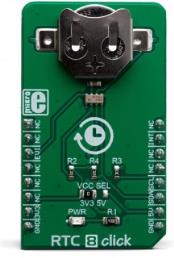
|
|
RTC 8 click is a real time clock module which has an extremely low power consumption, allowing it to be used with a single button cell battery, for an extended period of time. The RV-3028-C7 module built on the RTC 8 click is able to output the time in the standard format, as well as in the 32-bit UNIX format. Integrated, factory calibrated XTAL operating at 32.768 kHz ensures a very low time deviation. The compensation and offset data are stored within the internal non-volatile memory. There is also a possibility to password-protect the configuration parameters. An advanced interrupt feature allows many different uses such as alarm function, countdown timer function, external event detection function with time stamp and much more.
RTC 8 click is supported by a mikroSDK compliant library, which includes functions that simplify software development. This Click board™ comes as a fully tested product, ready to be used on a system equipped with the mikroBUS™ socket.
|
|
|
|
 |
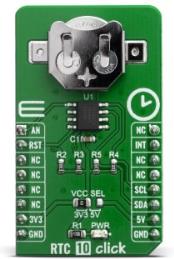
|
|
RTC 10 Click is a real-time clock module which has an extremely low power consumption, allowing it to be used with a single button cell battery, for an extended period of time. It features the DS3231M, a low-cost, extremely accurate, I2C real-time clock (RTC) from Maxim Integrated. The device incorporates a battery input and maintains accurate timekeeping when main power to the device is interrupted. The integration of the microelectromechanical systems (MEMS) resonator enhances the long-term accuracy of the device and reduces the piecepart count in a manufacturing line.
RTC 10 click is supported by a mikroSDK compliant library, which includes functions that simplify software development. This Click board™ comes as a fully tested product, ready to be used on a system equipped with the mikroBUS™ socket.
|
|
|
|
 |
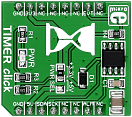
|
|
Timer click is a mikroBUS add-on board with Maxim's DS1682 total elapsed time recorder. The main feature of the IC is its elapsed time counter (ETC) used in conjunction with the ALARM pin. Whenever the EVENT pin is held high, the ETC will track time in quarter second resolution. Once the EVENT pin is set to logic low, the time data will be written in the IC's non volatile EEPROM. The next time the EVENT pin is pulled high, the timer will pick up where it left and continue measuring accumulated time. The upper limit is 34 years. In practical applications, the ALARM pin will be utilized to set off a flag once a certain threshold of accumulated time is reached. The alarm flag is one time programmable. The board communicates with the target MCU through the mikroBUS I2C interface, with two additional pins: ALARM (in place of default INT) and EVENT (in place of RST). Designed to use either a 3.3V or a 5V power supply. |
|
|
|
 |
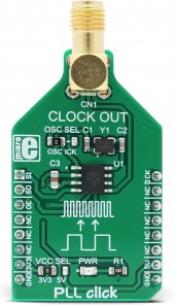
|
|
PLL click is a frequency multiplier which uses the Phase-Locked Loop (PLL) techniques to provide a high-frequency clock output from a cheap, standard fundamental mode crystal oscillator. In addition to this, PLL click also offers a choice between nine different multiplication factors, programmed via states of the two input pins. The output range of the PLL click goes up to 160MHz. |
|
|
|
 |

|
|
Watchdog Click is a compact add-on board that contains a simple countdown timer for a wide variety of applications. This board features the TPS3430, a standalone watchdog timer with a programmable watchdog window and programmable reset delay from Texas Instruments. The TPS3430 has the watchdog output reset delay set by factory-programmed default delay settings or programmed by an external capacitor. It achieves 2.5% timing accuracy at the typical temperature of 25°C and can be disabled via two SET pins to avoid undesired watchdog timeouts during the development process or Power-On. This Click board™ can be used as a countdown timer in MCU, DSP, FPGA, ASIC, and many more.
Watchdog Click is supported by a mikroSDK compliant library, which includes functions that simplify software development. This Click board™ comes as a fully tested product, ready to be used on a system equipped with the mikroBUS™ socket.
|
|
|
|
 |

|
|
Clock Gen 3 Click features a low power self-contained digital frequency source providing a precision frequency from 1kHz to 68MHz, set through a serial port. This Click board™, an I2C configurable clock generator, features the LTC6904 from Analog Devices and requires no external components other than a power supply bypass capacitor, and it operates over a single wide supply voltage range of 2.7V to 5.5V. The LTC6904 features a proprietary feedback loop that linearizes the relationship between digital control settings and frequency. It has many features that make it attractive for various applications such as a microcontroller clock source, clock source for a switched capacitor filter, or general replacement for a DAC/VCO combination.
Clock Gen 3 Click is supported by a mikroSDK compliant library, which includes functions that simplify software development. This Click board™ comes as a fully tested product, ready to be used on a system equipped with the mikroBUS™ socket.
|
|
|
|
 |

|
|
Clock Gen 5 Click is a compact add-on board that contains a digital programmable oscillator solution. This board features the LTC6903, a low-power self-contained digital frequency source providing a precision frequency from 1kHz to 68MHz set through a 3-wire SPI digital interface from Analog Devices. The LTC6903 features a proprietary feedback loop that linearizes the relationship between digital control setting and frequency and provides a smaller, more reliable, and vastly more versatile clocking solution. The frequency between 1kHz and 68MHz is set by a 16-bit control word, typically accurate within 1.1% with a resolution of 0.1% or better. This Click board™ is suitable for applications such as MCU clock source, clock source for a switched capacitor filter, or general replacement for a DAC/VCO combination.
Clock Gen 5 Click is supported by a mikroSDK compliant library, which includes functions that simplify software development. This Click board™ comes as a fully tested product, ready to be used on a system equipped with the mikroBUS™ socket.
|
|
|
|
 |
|

